Throughout our lives, our spine is extremely solicited...
The spine is composed of vertebrae, muscles and discs that separate the vertebrae and act as shock absorbers. Excessive stresses such as frequent and repetitive movements, carrying loads, intensive sports, or even sitting for long periods of time, etc., can lead to wear and tear on our spine and cause the majority of low back pain.
From a physiological point of view, the nucleus of the intervertebral discs is composed of 90% water, hence its shock absorbing properties. As the only non-vascularized tissue, the nucleus deflates when it is compressed. It only re-inflates by decreasing the pressure (osmosis) when we are lying down.
As with adults, back pain is increasingly common in children and adolescents. Specialists estimate that, depending on age, 20 to 50% of children between 10 and 15 years old have back pain.
During his schooling, a student spends approximately
6h30 per day of school, in a sitting position.

Unfortunately, school furniture is not suitable for every child. The size of children and adolescents varies greatly at each age, making it difficult to provide correct and appropriate furniture for each child in schools. In addition, the horizontal work surface forces the child to bend down and stoop to work.
Sitting for long periods of time at school
damages our children's backs... from the age of 6.
The consequences are mechanical and neurological.
Mechanical consequences
Abnormal stresses on the spine of children and adolescents during the sensitive period of growth influence the future of their backs and promote low back pain in adulthood.
The child's trunk muscles are not yet sufficiently developed and strong enough to withstand sitting for hours on end without great effort.
His attention in class decreases because it is then more directed towards this intense muscular effort which is imposed to him, generating distraction.
A well-fitting seat will help by reducing the muscular strain and mental effort required to sit for long periods. The child will become less restless in the chair.
By moving, children are often only trying to compensate for muscle tension.
Neurological consequences
In the classroom, there are two types of behavior in response to the constraints of sitting for long periods of time: the "quiet" child who does not move but eventually settles back in his or her seat; and the "fidgety" child who does not stop moving, is distracted and unfocused.
Between the ages of 6 and 12, the child is in full motor development. They still need to refine their body schema.
His brain uses tactile, proprioceptive, vestibular and visual integration mechanisms that result in either a muscle response or relaxation.
Why offer a cushion to your children?
The NOA cushion helps to maintain the three natural curves of the spine in the sitting position (see photo on the right) and to energize the sitting position.
Spontaneously, when sitting, the pelvis tends to tilt backwards (see photo on the left). The cushion facilitates the repositioning of the pelvis towards the front (see photo on the right).
This correct and natural posture is essential for maintaining attention, alertness, and listening skills and for promoting perseverance on the task.
Indeed, repositioning the head above the shoulders favors a good vascularization of the brain, beneficial for a good concentration and a better learning.

In addition, sitting the child on a dynamic seat cushion will cause imperceptible movements of the pelvic and back muscles that will allow the child to grow by strengthening the erector spinae muscles and avoid back pain caused by prolonged sitting.